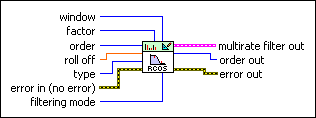DFD Raised Cosine Design VI
Owning Palette: Multirate Filter Design VIs
Installed With: Digital Filter Design Toolkit
Creates a raised cosine or a root-raised cosine finite impulse response (FIR) filter.
You can use the filter as a single-rate filter, an interpolation filter, or a decimation filter.

 Place on the block diagram Place on the block diagram |  Find on the Functions palette Find on the Functions palette |
 | window specifies the time-domain window this VI uses.
| ||||||||||||||||||||||
 | factor specifies the sampling frequency conversion factor of the multirate filter. The default is 4. The passband of the filter depends on factor by Nyquist sampling theorem. | ||||||||||||||||||||||
 | order specifies the filter order. The value must be an even integer that is greater than zero. The default is 10. If order is an odd number, this VI returns an error. Increasing the value of order can increase the stopband attenuation. | ||||||||||||||||||||||
 | roll off determines the relative transition bandwidth, which equals (transition band)/(2*passband + transition band). The default is 0.2. roll off must be in the range of [0,1]. If the value of factor is fixed, a smaller roll off value results in a narrower transition bandwidth. | ||||||||||||||||||||||
 | type specifies the type of filter that this VI creates.
| ||||||||||||||||||||||
 | error in describes error conditions that occur before this VI or function runs.
The default is no error. If an error occurred before this VI or function runs, the VI or function passes the error in value to error out. This VI or function runs normally only if no error occurred before this VI or function runs. If an error occurs while this VI or function runs, it runs normally and sets its own error status in error out. Use the Simple Error Handler or General Error Handler VIs to display the description of the error code. Use error in and error out to check errors and to specify execution order by wiring error out from one node to error in of the next node.
| ||||||||||||||||||||||
 | filtering mode specifies the processing mode of the filter that this VI creates.
| ||||||||||||||||||||||
 | multirate filter out returns a new multirate filter. | ||||||||||||||||||||||
 | order out returns the actual order of the new filter. | ||||||||||||||||||||||
 | error out contains error information. If error in indicates that an error occurred before this VI or function ran, error out contains the same error information. Otherwise, it describes the error status that this VI or function produces.
Right-click the error out front panel indicator and select Explain Error from the shortcut menu for more information about the error.
|
Example
Refer to the Raised Cosine Filter VI in the labview\examples\Digital Filter Design\Floating-Point Filters\Multirate directory for an example of using the DFD Raised Cosine Design VI.



